Old Village of Mount Pleasant SC: Mount Pleasant’s History
By Christina R. Butler/Butler Preservation for
Charleston Empire Properties – July 1st, 2020

The original plat creating the Crescent, 1926
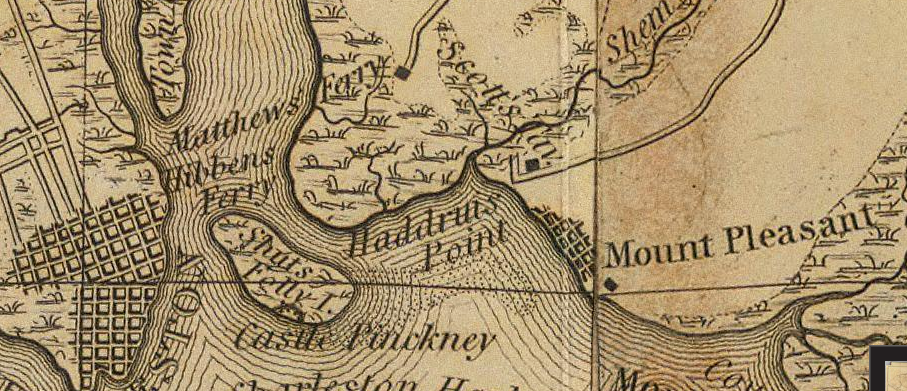
The Mills Atlas, Charleston District, showing Haddrell’s Point and Mount Pleasant (Old Village) in 1825
The historic Old Village of Mount Pleasant SC encompasses a large area that was originally known as Christ Church (one of many Anglican parishes that were used as place names), Homes for sale in Old Village, Mt. Pleasant, SC offer a unique connection to this historic region, which was developed as a series of creekside plantations by early settlers. In the colonial era, part of the land that became the Old Village was known as Mount Pleasant Plantation. Perched on a bluff next to the Cooper River, the original plantation house (now called Hibben House) was built in 1759 by Jacob Motte, and was seized for by the British for use as a headquarters during the American Revolution.
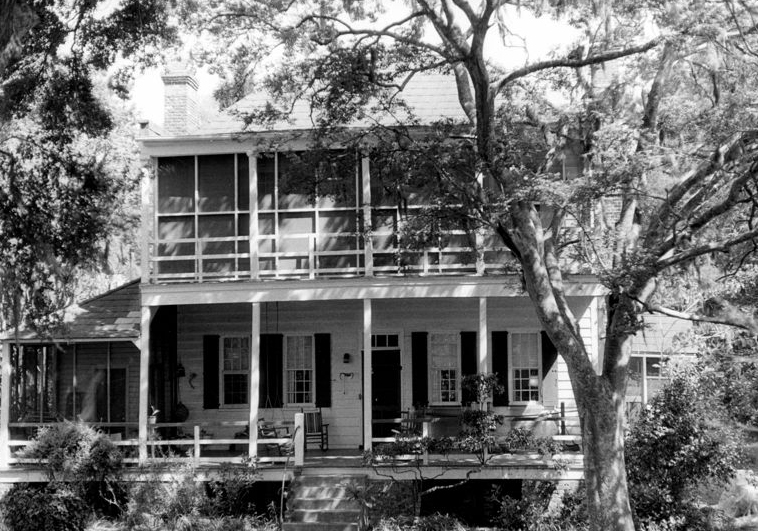
The front and rear of the circa 1795 Hibben House in 1970.
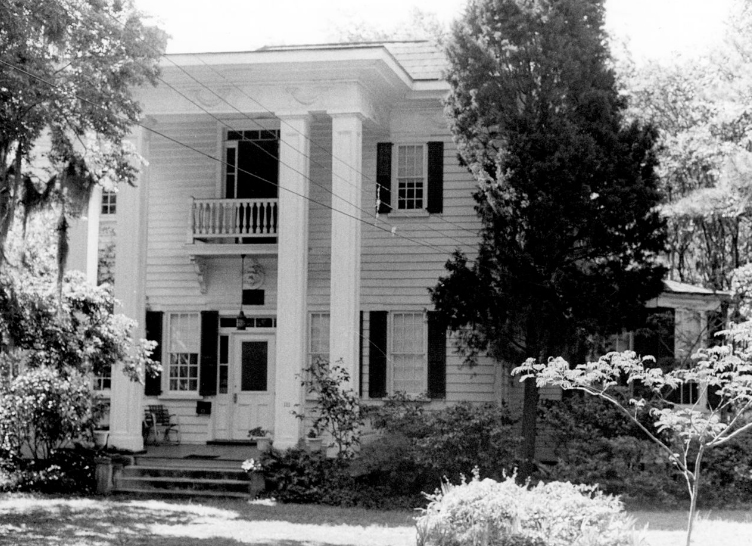
Mount Pleasant's history began with Jonathon Scott created Greenwich Village in 1766, the first of its kind east of the Cooper and was adjacent to Mount Pleasant plantation. Homes for sale in Old Village, Mt. Pleasant, SC reflect the area's rich history, including Greenwich’s large waterfront lots and a common greenspace typical of English planning practices of that time. In 1803, English-born state senator and prominent businessman James Hibben purchased Mount Pleasant Plantation and created Mount Pleasant village on the farmstead, with thirty five residential lots along Beach, Bennett, Whilden, Boundary, and Venning Streets. He also owned the Ferry Tract, which is part of the Old Village today. Greenwich and Mount Pleasant merged in 1837. Homes for sale in Old Village, Mt. Pleasant, SC often highlight this historic area, which was popular as a summer resort for Christ Church planters, and many eventually made permanent residences there. An article from 1858 noted that the Village’s early buildings were “nearly all built in the good old times when people were satisfied with plain one story cottages.”

An 1838 plat of the Hibben Ferry Tract, showing the beach and ferry landing.
At the end of the American Civil War, the Whilden House near the waterfront on Bennett Street (built in 1840 and named for planter and mayor Elias Whilden) served as a Union headquarters. The famous African American volunteer regiment 54th Massachusetts was stationed there in 1865.
The historic Old Village of Mount Pleasant SC saw a post-war building boom and in 1872, several of the small early settlements merged as one entity and became the incorporated Town of Mount Pleasant. These included Hilliardsville (1847), Lucasville on Haddrell’s Point (created by William Lucas in 1853, who received most of the tract from his famous rice planter and mill engineer father Jonathan Lucas ) Greenwich (1766), Hibben Ferry Tract (1770), and Mount Pleasant (1808), together, they now form the Mount Pleasant Historic District, where homes for sale in Old Village, Mt. Pleasant, SC, offer a chance to live within this rich tapestry of history.
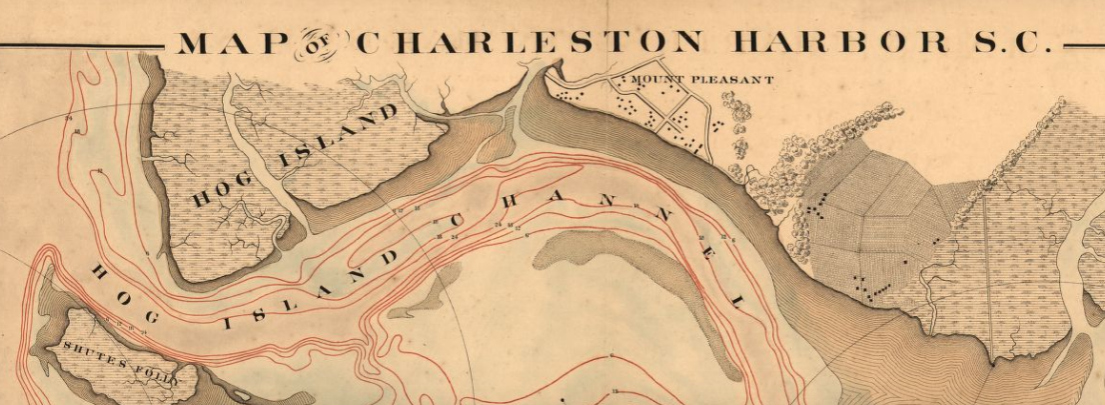
Old Village/Mount Pleasant on a Map of Charleston Harbor, 1865. Library of Congress.(courtesy of Olmsted Historic Site, NPS.)
In former Hilliardsville, the Osgood family of Massachusetts bought a large waterfront lot in 1929 and erected a substantial seawall, behind which they created seven pleasure gardens collectively called Pierates Cruze, which they opened to the public in 1943. Although the gardens closed in 1959 and the land sold, there are still surviving garden features, such as the Belled Wall, which was reconstructed after Hurricane Hugo in 1989. Nearby is the current Alhambra Hall, a recreation building with a waterfront picnic area, was built in 1937 to replace an earlier building. Homes for sale in Old Village, Mt. Pleasant, SC provide access to this historic area and its unique landmarks.
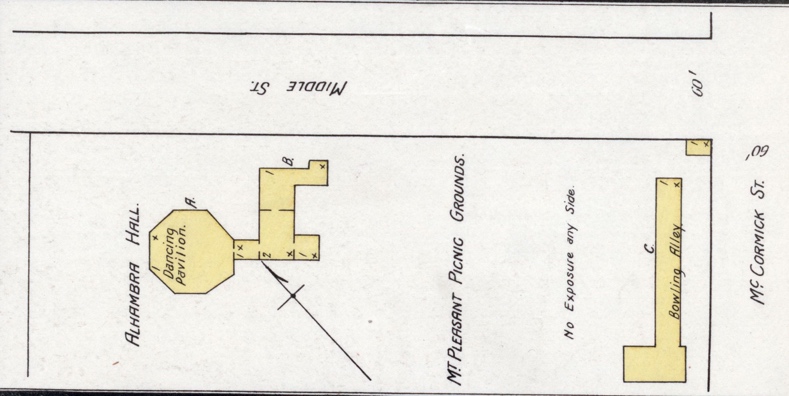
Original Alhambra Hall, 1893, and the 1937 hall pictured today.
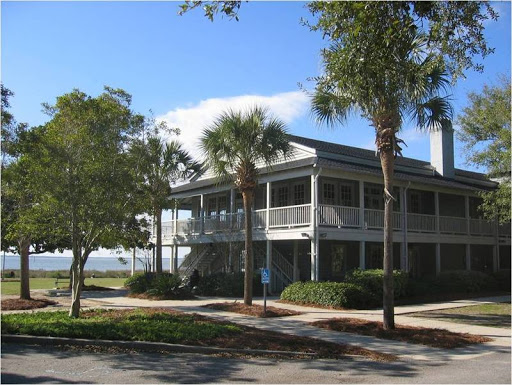
The historic Old Village of Mount Pleasant, SC today has an eclectic blend of historic houses of various sizes and styles, including Victorian wood frame houses that reflect the late nineteenth century popularity of the area. Homes for sale in Old Village, Mt. Pleasant, SC cater to a wide range of architectural taste: large antebellum homes, brick houses in traditional Colonial Revival styles, smaller brick clad houses from the 1940s and 1950s on the periphery, and large new houses with neotraditional details, wide porches, and waterfront views.

409 Church Street, built in 1847, is currently listed.
The Old Village also has several historic churches with active congregations: Mount Pleasant Presbyterian on Church Street (built in a fold Roman Revival style in 1854), St. Andrew’s Episcopal on Whilden Street (a lovely Carpenter Gothic building constructed in 1857), St. Paul’s Lutheran on Pitt Street (1884) and Friendship A.M.E. on Royall Avenue (on the same location since 1890, and remodeled extensively after the Hurricane of 1911). Homes for sale in Old Village, Mt. Pleasant, SC offer proximity to these architectural and historical treasures.

) Mt. Pleasant Presbyterian and St. Andrews Episcopal in 1970. Charleston Archive, CCPL.


City Directory ad for the Mount Pleasant ferry to Hibben’s landing.
Development crept into the historic Old Village of Mount Pleasant SC after the Grace Bridge opened in 1929, and several new subdivisions cropped up East of the Cooper. There are several houses in Old Village and to the north of Royall Drive that date to this era of growth. The Pearman Bridge opened in 1966 to keep up with development. Mount Pleasant’s population has increased exponentially in the last thirty years, but preservation minded residents and politicians saw the writing on the wall and moved to create the Old Village of Mount Pleasant History Commission in 1989, which has allowed the area to retain its unique character and small town scale. The Village was also added to the National Register of Historic Places in 1973. Homes for sale in Old Village, Mt. Pleasant, SC offer a rare opportunity to live in this historically rich and carefully preserved community.

A state historical marker for the Old Village.
The historic Old Village of Mount Pleasant SC retains all of the functions and amenities of a traditional village, with shopping and restaurants and recreational amenities below mature shade trees. The Village is bounded on almost all sides by parks and waterways, including Pitt Street Bridge Park, Alhambra Playground, Center Street Park, Edwards Park, a recreational field, and Simmons Marina on Shem Creek. Shops include the famous Pitt Street Pharmacy with its historic soda fountain, several restaurants, a historic post office, and the Village Library branch. The homes for sale in Old Village, Mt. Pleasant, SC attracts retirees in search of quiet southern character, and young families looking for yard space and critically acclaimed schools (Wando high, Moultrie Middle, and Mount Pleasant Academy). Th Old Village retains its walkable, small town feel and community character, and it is easy to see why its houses and few remaining undeveloped waterfront lots are highly sought after.
Explore the timeless appeal of the Old Village in Mount Pleasant, SC, where historic charm meets contemporary living. This coastal neighborhood, which once thrived as a peaceful settlement, now stands as a lively and sought-after area. Its tree-lined streets, distinctive homes, and picturesque atmosphere make it a true Southern treasure.
Experience the essence of this unique community and its rich history as you browse its charming properties. Let Charleston Empire Properties guide you to the perfect home that embodies the elegance and heritage of the Old Village, whether you're exploring homes for sale in Charleston, SC or seeking your dream residence.

A Pitt Street house, currently on the market, which showcases the Old Village’s character.
Sources:
– Nic Butler, “The First Century of Ferry Service Across the Cooper River.” Charleston Time Machine, 25 May 2018. https://www.ccpl.org/charleston-time-machine/first-century-ferry-service-across-cooper-river
– Nic Butler, “Zenith and Decline of the Ferry Service Across Cooper River.” Charleston Time Machine, 1 June 2018. https://www.ccpl.org/charleston-time-machine/zenith-and-decline-ferry-service-across-cooper-river
– Christina Butler. “Bateau to Barge: A History of Lowcountry Transportation.” Kiawah Legends. Vol. 34, Spring 2020.
– Town of Mount Pleasant. “Old Village Historic District.” https://www.tompsc.com/241/Old-Village-Historical-District
– National Register of Historic Places. “Mount Pleasant Historic District.” May 1972.
– Town of Mount Pleasant Historical Commission, “The Old Village,” Mount Pleasant Historical, accessed June 20, 2020, http://mountpleasanthistorical.org/items/show/43.
– Mary-Julia Royall. Mount Pleasant: Victorian Village. Charleston: Arcadia Publishing, 1997.
– Historic maps and plats
– Petrona Royall McIver. The History of Mount Pleasant. Charleston: Ashley Print and Publication Company, 1960.
– Susannah Smith Miles. East Cooper Gazatteer: peoples, places, and events in history. Charleston: History Press, 2004.
– National Register photos by George Bayless. Charleston Archive, CCPL.

